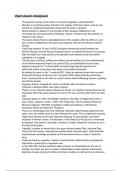Virgil’s Aeneid - Background
- The general purpose of the poem is to preach Augustian values/Stoicism.
- Stoicism is an ethical system infused in the entirety of Roman culture, and we can
use this to understand Augustian values and the poem in general.
- Greek Stoicism is based on the principle of the complete indifference to all
circumstances and suppression of feelings, desires, emotions and the passions in
reaction to the nature.
- The poem reflects Rome's disestablishment of the republic after the strife of a civil
war, and the establishment of peace and prosperity with the new Roman Imperial
Empire.
- Virgil lived between 70 and 19 BCE during the transitional period between the
Roman Republic into the Roman Imperial Empire, he ordered the book to be burned
after his death but it was saved by his assistant and therefore is still somewhat
unfinished in it’s logisity
- The 80 years of ethical, political and militant turmoil leading up to the establishment
of the Roman Imperial Empire (1st century BCE) are embedded into the poem,
despite it being set in 11 century BCE, because Virgil lived through this era.
- Half of the events in the poem take place on the Italian Peninsula.
- By setting the poem in the 11 century BCE, Virgil can address issues that occurred
during the 80 years of turmoil in the 1st century BCE without directly mentioning
them, meaning that he can refer to current issues without offending anyone or getting
himself into trouble.
- Augustus Caesar changed his name to Octavian after he became emperor
(Octavian’s adoptive father was Julius Caesar)
- There is a lot of Roman history infused into books 1-6, despite it being known as the
Odyssean half of the poem because it’s set on the sea, and the other half is the Iliac
half.
- Important dates: C.1500-1300 Middle Versions of the Epic of Gilgamesh found in
Iraq, Turkey, Lebanon, Israel, c1250-1175 Trojan War, 753 Founding of Rome by
Romulus (legend), c750-600 compilation of Iliad and Odyssey, c700 Hesiod
composes Works and days and Theogony
- There is a mythological and even historical character called Aeneas external to the
poem, who was written about by other Romans for years. This is significant because
Virgil chose Aeneid as the main character because he was already a prevalent
character in Roman culture. For example, in Ilios Persis by Proclus he is mentioned
to abandon Troy before it was taken, however in Virgil’s Aeneid he is shown to be in
the thick of the action.
- Logically, it makes no sense that in the poem Aeneas meets Dido, because Dido
lived in the 9th century, meaning they existed three centuries apart. Virgil stretched
actual factual knowledge accepted by Roman/Greek history in order to write the
story.
- Virgil was hired by Augustus’ Caesar to write Roman Imperial Empire propaganda
that shone a good light on Augustian rule.
- In the Little Iliad, Aeneas had been taken prisoner by Neoptomlemus, the son of
Achilles, and there are also a number of black-figure vases painted by Etruscans
depicting Aeneas carrying his father Anchises to safety, as well as his son Ascanius.




